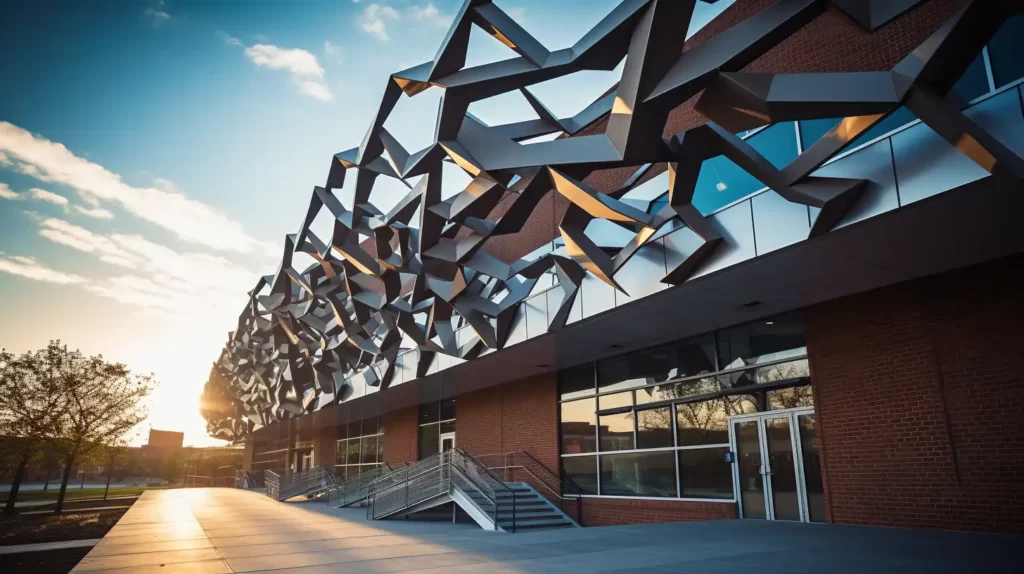In the dynamic world of entertainment, the design and structure of venues play a crucial role in enhancing audience experiences. One element that stands out in modern venue design is the use of architectural metal. This material is not only pivotal in shaping the aesthetics of entertainment spaces but also in improving their functionality. In this article, we will explore the fascinating role of architectural metal in entertainment venues, highlighting its diverse applications and benefits.

The Rise of Architectural Metal in Venues
The use of architectural metal in construction has gained popularity over the years, particularly in entertainment venues. This rise can be attributed to its versatility, durability, and the unique aesthetic appeal it provides. From concert halls to theaters, architectural metal adds a modern touch while ensuring structural integrity.
Benefits of Architectural Metal in Entertainment Venues
1. Aesthetic Appeal
One of the primary reasons for incorporating architectural metal in entertainment venues is its aesthetic appeal. Metals like aluminum, steel, and copper can be crafted into intricate designs, enhancing the visual impact of a venue. These designs can range from sleek modern lines to more elaborate and artistic patterns, offering endless possibilities for architects and designers.
2. Durability and Longevity
Entertainment venues require materials that can withstand the test of time and heavy usage. Architectural metal is known for its durability and resistance to wear and tear. This makes it an ideal choice for high-traffic areas such as concert halls and stadiums where maintenance is a constant concern.
3. Flexibility in Design
The flexibility of architectural metal allows for innovative designs that are both functional and artistic. Whether it’s creating 3D facades or intricate interior elements, metal can be molded and shaped to meet the specific needs of a venue.
4. Sustainability
As the world moves towards sustainable building practices, architectural metal stands out as an eco-friendly option. Metals are often recyclable, reducing the environmental impact of construction projects. This aligns with the growing demand for sustainable and green building solutions in the entertainment industry.
Applications of Architectural Metal in Entertainment Venues
1. Facades and Exteriors
The exterior of an entertainment venue is the first impression visitors get. Using architectural metal for facades not only enhances the building’s appearance but also offers protection against environmental elements. Metal facades can be crafted into various designs, offering a unique identity to each venue.
2. Interior Design Elements
Inside the venue, architectural metal can be used for various design elements such as staircases, railings, and decorative panels. These elements not only contribute to the overall aesthetic but also offer practical benefits such as safety and support.
3. Acoustic Enhancements
In spaces like theaters and concert halls, acoustics play a crucial role in the audience’s experience. Architectural metal can be used to create acoustic panels that enhance sound quality, ensuring that every note or dialogue is heard clearly.
Challenges and Considerations
1. Cost Implications
While architectural metal offers numerous benefits, it can be more expensive than traditional building materials. However, considering its durability and low maintenance costs, it often proves to be a cost-effective solution in the long run.
2. Installation Expertise
The installation of architectural metal requires skilled professionals to ensure precision and quality. Venue owners must invest in experienced contractors who understand the intricacies of working with metal.
Future Trends in Architectural Metal for Venues
1. Technological Advancements
As technology advances, new methods of fabricating and installing architectural metal are emerging. Techniques like laser cutting and 3D printing are revolutionizing the way metals are used in construction, offering even more design possibilities.
2. Integration with Technology
Entertainment venues are increasingly incorporating technology into their design. Architectural metal can be integrated with lighting systems and digital displays, creating interactive and dynamic environments for events.
Conclusion
The role of architectural metal in entertainment venues is undeniably significant. Its ability to enhance aesthetics, improve functionality, and offer sustainable solutions makes it an essential component of modern venue design. As the industry continues to evolve, the use of metal is set to play an even greater role in creating captivating and efficient entertainment spaces.

FAQs
1. Why is architectural metal preferred in entertainment venues?
Architectural metal is preferred for its durability, aesthetic appeal, and versatility. It allows for innovative designs while offering structural integrity and sustainability.
2. What types of metals are commonly used in architectural design?
Common metals include aluminum, steel, and copper. Each offers unique properties suitable for different design requirements and aesthetic goals.
3. How does architectural metal contribute to sustainability?
Metals are often recyclable, reducing environmental impact. Their durability also means less frequent replacements, contributing to sustainable building practices.
Explore more about architectural metal fabricators and their role in modern construction to understand its growing popularity in the industry.
This article contains affiliate links. We may earn a commission at no extra cost to you.

